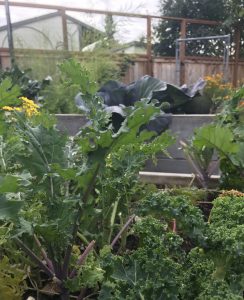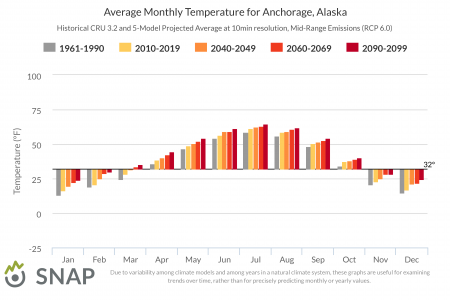
Photo by author.
Gardening in North Anchorage
Every spring I feel a hint of jealousy when my mother describes the new growth in her garden. She lives in New York state where she enjoys a longer frost-free period and Zone 6a hardiness. Just like any northern climate, gardening in Anchorage has challenges. However, with careful site and plant selection, by the end of summer it’s not too hard to have an abundant garden that makes even a New York mother envious.
Between the moderating effect of Cook Inlet’s water and the steep rise in elevation of the Chugach mountains to the east, there are multiple micro-climates within the municipality of Anchorage. North Anchorage, in the north-central area of the city, is located in between these two geographic features resulting in a climate that is roughly average for the city as a whole.

Challenges of gardening in Anchorage are similar to other northern climates including short growing seasons with need for season-extending techniques, limited plant selection, and cold winters that prey on un-mulched perennials. However, in comparison to other regions around the state, some with significantly colder climates and shorter growing seasons, these challenges are not too difficult to overcome.
One of the greatest benefits of growing in Anchorage is that, since overcoming the challenges of cold climate gardening takes a bit of effort, the results are incredibly rewarding. Also, it isn’t just the satisfaction of a job well done making the carrots taste sweet. . .they actually are sweeter because of the long day length.
Nearest weather station: Merrill Field
Temperature and Precipitation Normals from 1981-2010
Data below is from the NOAA National Centers for Environmental Information “Normals Monthly” for Merrill Field Weather Station.
|
May |
June | July | August |
September |
|
| Average Daily Temperature ( °F) |
49.3 |
56.8 | 60.7 | 57.7 |
49.3 |
| Average Daily Maximum ( °F) |
57.6 |
64.8 | 68.0 | 64.6 |
56.3 |
| Average Daily Minimum ( °F) |
41 |
48.9 | 53.5 | 50.8 |
42.2 |
| Average rainfall (in.) |
0.79 |
1.20 | 2.07 | 3.12 |
3.23 |
Data below is from the NOAA National Centers for Environmental Information “Normals Annual/Seasonal” for Merrill Field Weather Station.
| 32 °F is used here to determine frosts. |
Probable Growing Season (90% probability) |
Possible Growing Season (10% probability) |
| Date of First Frost |
9/15 |
10/10 |
| Date of Last Frost |
05/09 |
4/18 |
| Freeze Free Period |
130 |
176 |
When Day Lengths are Longer than 12 Hours: 3/18 to 9/25
Temperature and Precipitation Data for 2018
Data below is from the NOAA National Centers for Environmental Information “Global Summary of the Month” and “Daily Summaries” for Merrill Field Weather Station.
|
May |
June | July | August |
September |
|
| Average Daily Temperature ( °F) |
48.9 |
57.3 | 62.1 | 58.2 |
53.7 |
| Comparison to Temperature Normals ( °F) |
-0.3 |
+0.5 | +1.4 | +0.5 |
+4.4 |
| Rainfall (in.) |
0.56 |
1.83 | 1.52 | 3.96 |
1.11 |
| Comparison to Rainfall Normals (in.) |
-0.21 |
+0.63 | -0.55 | +0.84 |
-2.12 |
Date of Last Frost: 4/27/18
As of October 16th, No temperatures 32 °F or less have been recorded at Merrill Field Weather Station yet this fall. My garden, a very short distance away, has suffered light frost with home thermometer readings as low as 30 °F.
Projected Future Average Monthly Temperature
This year, 2018, has been a warm year with average summer temperatures above the norms. One year cannot be looked at in isolation to make statements about climate change. However, the below graph from SNAP (Scenarios Networking for Alaska + Arctic Planning), part of the International Arctic Research Center at The University of Alaska Fairbanks, shows warming in comparison to historical norms and well as projections for ongoing warming through the end of this century. This projection suggests that growing season and plant hardiness zone will likely change in the coming years.

Marah, you may have a hint of jealousy about your mom’s gardening zone (understandable), but I am super jealous of your very tall, sturdy, moose repelling fence! Loved your article; especially the photo of the cold tolerant tomato plant. That’s crazy.